NYC’s Forgotten ‘War on Christmas Trees’
Discover how an obscure holiday crackdown affects festive street vendors today!



Photo by Mike Groll/Office of Governor Andrew M. Cuomo
It’s August tomorrow, one of the last prime months of the year for a significant new influx of public art installations. Despite the bracing heat, New Yorkers are out in the city and we’ve included here both significant public art works outdoors and a few indoors, at large scale and small. Street art works dominate some of the new offerings, but unique sculptural works, including a geodesic dome are also ready for discovery. See if you can stop by them all this month!
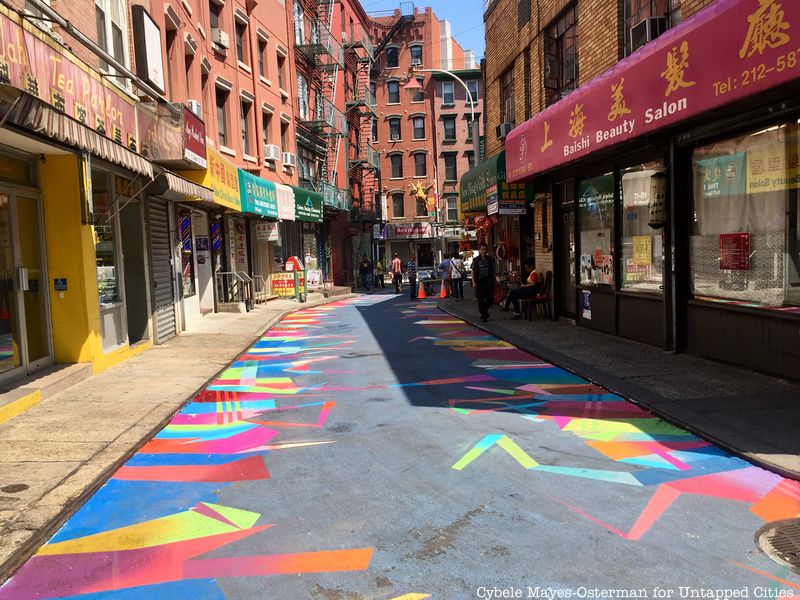
Chinatown’s historic Doyers Street has become the site of the annual Chinatown Seasonal Streets program. The entire block has been closed off until 9 pm every night by the Chinatown Partnership as a public space, and the street itself has been spraypainted with colorful patterns by the Bronx-born street artist Moncho1929. This is the second year of the Asphalt Art program, following the Hangzhou artist Chen Dongfan‘s work on the street last July.
Doyers Street earned the nickname of the “Bloody Angle” during the early 20th century because its blind corner-type shape made it a convenient place for an ambush. In 1909, the actor Ah Foon was chased down a tunnel that runs under the street by gangs and shot on the landing of his apartment, cementing the street’s reputation.

Photo by Evan Joseph courtesy Empire State Building
As part of a brand new museum space inside the Empire State Building, King Kong comes crashing in the windows. The culmination of a $165 million transformation, the Observatory Experience allows visitors to the famed observatory on the 86th floor to will walk through a museum experience and take a journey into the history of the great skyscraper – all instead of waiting on a long line to get to the top. As visitors walk through the exhibit, they will have the opportunity to see back in time to the history of the skyscraper’s construction and the extraordinary construction process that made it unprecedented for its time.
One part of the exhibit focuses on the giant body of movies and media in which the Empire State Building has starred. One room is surrounded by windows showing what the view from the top observatory would have looked like in the ’30s, while a moving King Kong appears to peer back at you from his perch outside. Cooper said of the process, “They took us out onto these ledges on [floors] 87 and 88 to do filming for construction. The constructed area is a photograph of the city that’s then been converted back to the 1930’s…by photoshopping the background.” In addition to King Kong and historical exhibitions, visitors can experience a recreation of an original elevator, a design by Otis that was groundbreaking for its time.

Photo by Mike Groll/Office of Governor Andrew M. Cuomo
In South Brooklyn along Jamaica Bay, New York City’s largest state park has just opened. When fully completed, the Shirley Chisholm State Park, located just south of Starrett City, will be 407-acres. The park features a large, colorful mural honoring Chisholm, the first African American woman elected to Congress by street artist Danielle Mastrion.
Earlier in June marked the completion of the park’s $20 million first phase of construction, with amenities including ten miles of biking and hiking trails, a pier for fishing and picnicking, and water access.
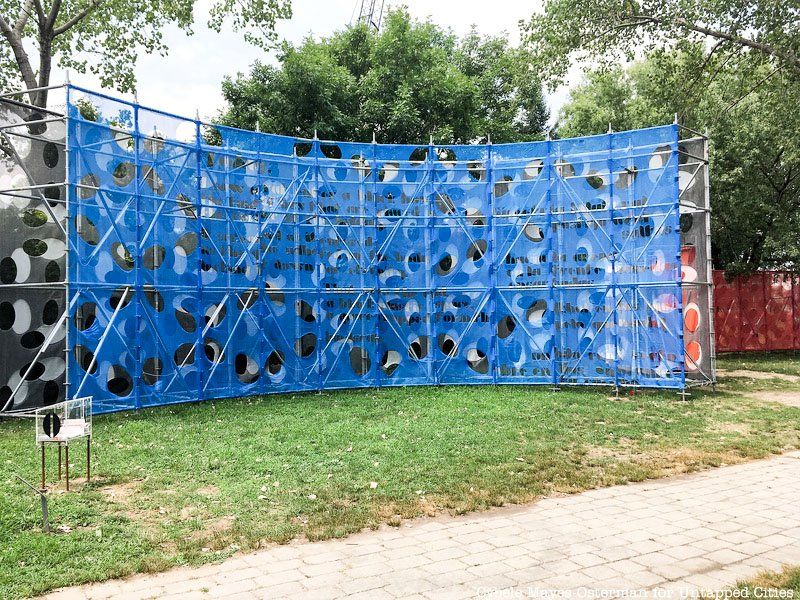
Socrate Sculpture Park in Queens is a great place to take in art and the views of Manhattan along the East River. A new large-scale work is in process by artist Rafael Domenech. Las Palabras son Muros [Pavilion for Astoria] (The Words are Walls [Pavilion for Astoria]) is made of scaffolding and construction mesh, with “pages” hanging that show graphically dynamic laser-cut texts that rotate throughout the exhibition.
The text comes from actual visitors to the park who submit words, phrases and stories, which then get selected by a digital algorithm. You can also submit a message online at laspalabrassonmuros.info. When the 16-week exhibition is over, Domenech will make a book that will incorporate the texts.
Las Palabras son Muros [Pavilion for Astoria] will be up until November 3, 2019.

A new mural in NoMad pays homage to the neighborhood’s past and the Gilded Age’s most infamous beauty, Evelyn Nesbit, who captivated New York City at the turn of the last century. Commissioned by the Kaufman Organization, the 97-foot tall mural was created by street artist Tristan Eaton on the side of 236 Fifth Avenue at West 27th Street in the heart of NoMad.
Nicknamed “The Gilded Lady,” the mural recalls a time when the area was the playground of the well-to-do with shops and restaurants as well as bars, bordellos, dance halls, gambling dens, and other places of entertainment. The mural incorporates a myriad of images including theatre bills, an eagle sculpture from the second Madison Square Garden, a policeman’s copper badge, and even a Tenderloin steak (a nod to an earlier name for the seedier section of the neighborhood). Dominating the mural though is the face of Evelyn Nesbit, model, muse, and show girl who was at the center of the original Trial of the Century. Read more about her here.
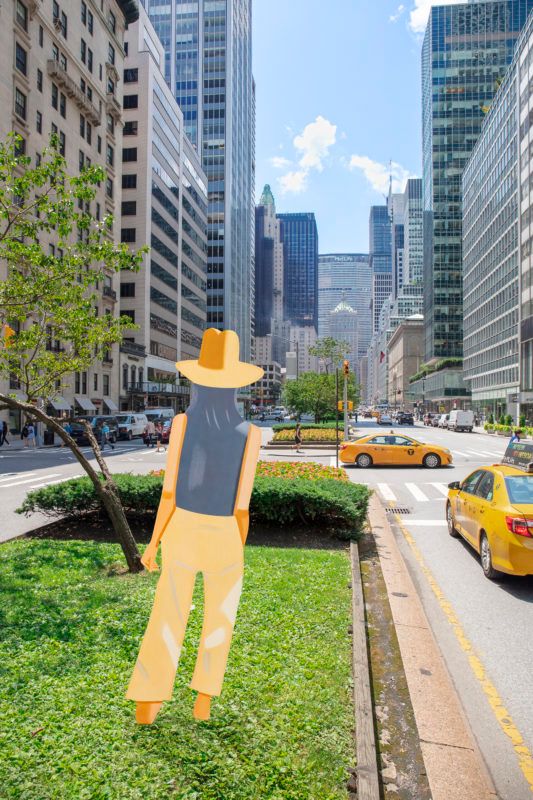
Photo by Diego Flores.
The current work on the Park Avenue Malls, Joseph La Piana’s Tension Sculptures (featured later in this piece) will be on display until August 11th, but later this month, the new installation will up, sponsored by the Fund for Park Avenue and NYC Parks’ Art in the Park program. Park Avenue Departure by Alex Katz will be a series of seven colorful, cut-out sculptures that, at first glance, resemble the backs of passersby that you might see while strolling down the street. But the works appear differently to the observer from different vantage points, adding an extra level of perceptive depth, similar to an optical illusion. With 200 solo exhibitions and 500 group exhibits under his belt, including appearances at the Whitney, the Brooklyn Museum of Art, the Jewish Museum, and the Guggenheim, Katz’s work has become a New York classic.
Park Avenue Departure will open on the 26th of August and close September 10th. The work is also co-produced by Lococo Fine Art Publisher and Kasmin Gallery.
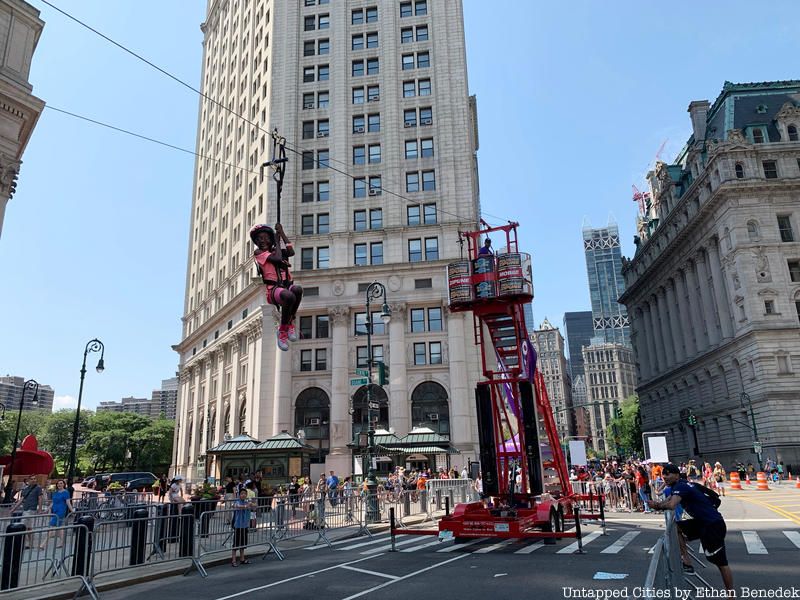
Summer Streets an annual closing off of almost seven miles of streets to traffic for pedestrian use, has become a New York City summertime favorite. This year, the area around Park Avenue from Brooklyn Bridge to Central Park will open up to free use for walking, biking, playing, or any other creative forms of exercise for the first three Saturdays of August from 7 am to 1 pm.
The event this month will also feature a multitude of public art installations, activities, and events, like a rock climbing wall, a zipline, fitness classes, and workshops. The celebration is the work of New York’s Department of Transportation, and is modeled on other public outdoor gatherings from around the world.
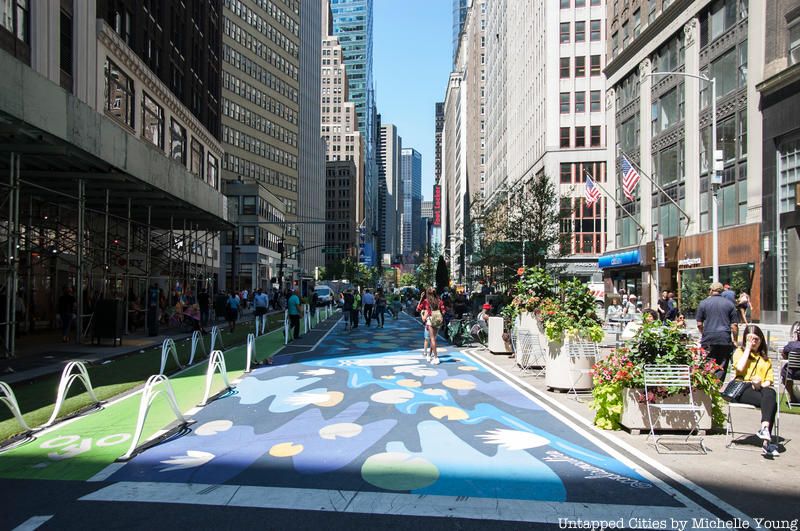
The Garment District Urban Garden, a conglomeration of public artwork and community programs, has taken over two whole blocks on Broadway from July 10th until the end of August. The space between 37th and 38th Streets features Nymph Pond, a mural spanning the entire stretch of road. The Ecuadorian artist, Carla Torres, said she based the mural on a pond she would visit in the Galapagos Islands.
Meanwhile, the blocks between 36th and 37th and 39th and 40th Streets is the site of the 400-foot mural, Sew and Sew. The artist, Steed Taylor, calls his piece a “road tattoo” that weaves a thread-like pattern with the names of 100 people have worked in the Garment District for over 20 years. The installations were commissioned by Garment District Art on the Plazas, a program organizing public art displays that is run by Arterventions, a division of the Department of Transportation’s Art Program, and the community initiative the Garment District Alliance.
Besides the artwork, the Urban Garden is the site of multiple other events open to the public over the summer, like outdoor fitness classes, live music, and free lemonade provided by Broadway Squeeze. Additionally, the whole block surrounding the work has also been revamped, with newly planted greenery and outdoor tables and chairs for public use.
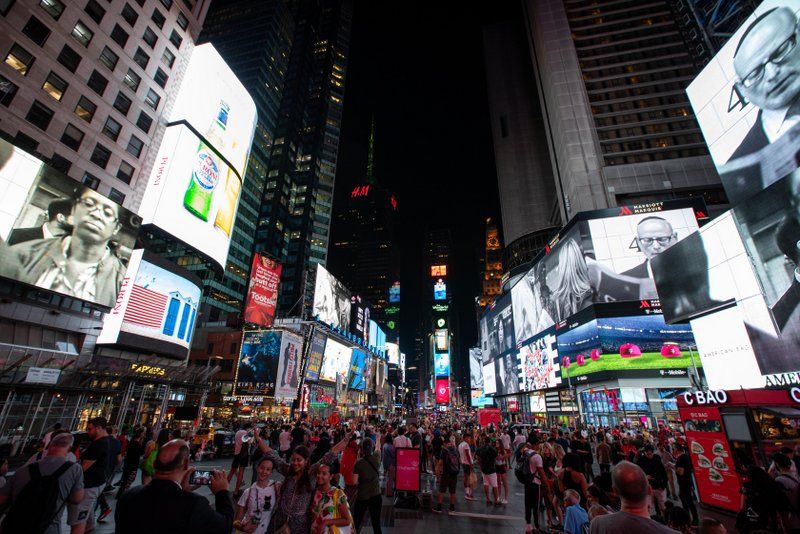 Adam Magyar, Stainless. Photo by Walter Wlodarczyk for Times Square Arts.
Adam Magyar, Stainless. Photo by Walter Wlodarczyk for Times Square Arts.
Every month a new video installation takes over the screens of Times Square at midnight. The Midnight Moment videos run every night at midnight. This month, the screens will be taken over by photographer and videographer Adam Magyar, for a series called Stainless that shows daily life in the largest cities on the globe. According to Times Square Arts, in a “hypnotic video, Magyar slows time almost to a halt for everything but his camera, which travels down a subway platform in New York City, memorializing commuters in the moment of the train’s arrival.”
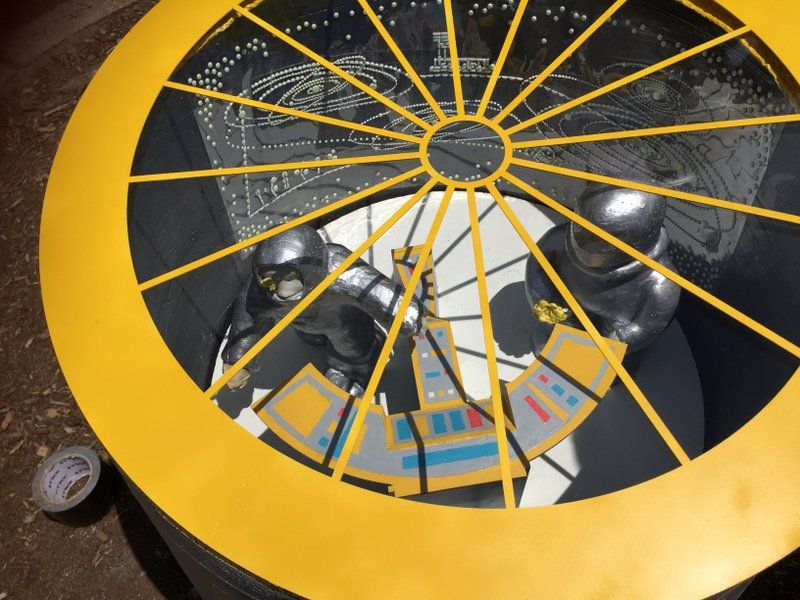
Photo courtesy NYC Parks
A new public art installation by Queens-based artist Yvonne Shortt, has just been unveiled in Flushing Meadows-Corona Park. Shortt’s immersive installation, titled Pavilion Landing, is clearly inspired by shape of the iconic New York State Pavilion (aka Tent of Tomorrow), which was painted in “American Cheese Yellow” color in 2015 as part of a restoration effort. Created in response to the theme “Flushing Meadows Corona Park: A Park for the Future,” it tells the story of intergalactic children whose spaceship has landed in the park. The artist worked with park visitors to create sculptures of children out of clay, which she then cast in concrete.
Funded by the Alliance for Flushing Meadows Corona Park in collaboration with NYC Park’s Art in the Parks program, Pavilion Landing is part of an effort to bring contemporary public artworks to the city’s parks. The goal of the program, as announced by NYC Parks Commissioner Mitchell J. Silver, is to “promote the less frequented core of our parks and support local artists.” Pavilion Landing can be found at the 111th Street and 49th Avenue Park entrance, located on the lawn alongside David Dinkins Circle. It will be on display until June 2020.
Visit this installation while on either our next tour of the Remnants of the World’s Fairs or on an Untapped Insiders special visit inside the Queens Museum with the new President of the museum.
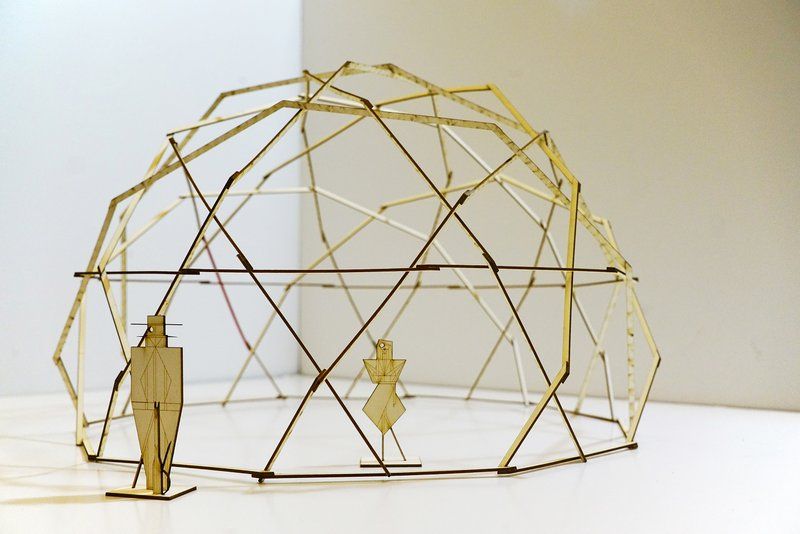
Photo courtesy Marvel Architects
On the campus of Snug Harbor Cultural Center & Botanical Garden on Staten Island, a new collaborative public art project is just about to open to the public. A temporary, wooden geodesic dome about 30 feet wide and 18 feet high was created by Jonathan Marvel and staff from Marvel Architects and Deacon Marvel and inspired by the Buckminster Fuller Dome by American architect R. Buckminster Fuller. Deacon Marvel, Principal at Deacon Marvel, has also elaborated that the dome was “originally built in 1963, when Bucky and his team of geodesic designers were experimenting with alternative means of enclosing space with the minimum amount of structure, using commonly available building materials.”
Assembled as a pavilion, it is a spherical structure composed of an interwoven network of modular struts. The dome is part of a mission to add vibrancy to Snug Harbor, one of the largest ongoing adaptive reuse projects in America. Aileen Fuchs, President & CEO of Snug Harbor, looks forward to guests being able to explore the dome as well as partake in the other programs and events offered. The dome will be located along Chapel Road across from Building K as a new addition to the other 28 structures, botanical gardens, acres of wetlands, and the two-acre urban farm of Snug Harbor.
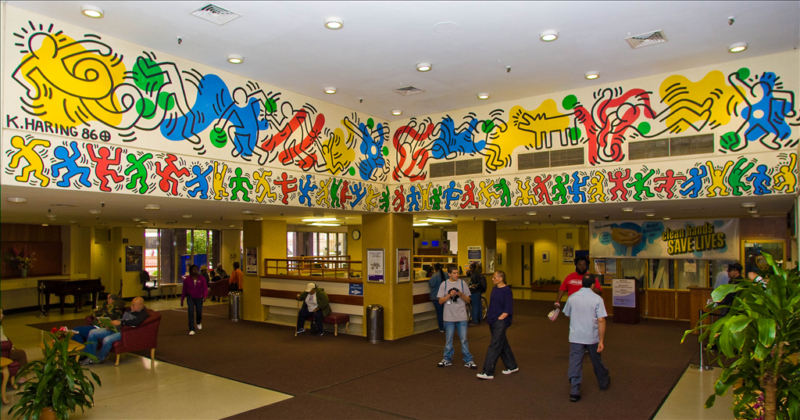
Photo of a mural designed by Keith Haring in 1986. A NYC Health + Hospitals facility has not received a mural since then. Photo: NYC Health + Hospitals/Woodhull
In 1986, Keith Haring designed a mural for Woodhull Hospital in Queens, but no NYC Health + Hospitals facility has received a mural since then. That is changing this month, as NYC Health + Hospitals’ Arts in Medicine program embarks on a community-based mural projects across New York City with nine selected artists. The process is expected to be completed by the end of December 2019. These collaborations between artists, patients, staff, and local community residents are intended not just to promote the work of local artists, but to also build trust and engagement between hospitals and their communities.
Supported by the Laurie M. Tisch Illumination Fund and the Mayor’s Fund to Advance New York City, the murals will be created both inside and outside NYC Health + Hospital facilities. Eric Wei, MD, MBA, Vice President and Chief Quality Officer of NYC Health + Hospitals, and Chair of the Art Advisory Council, has in particular emphasized how “it is clear from decades of research that arts promote healing in many important ways.” The idea for the collaborative mural process was developed in the belief that art would be more than just an installation, and that the art would also promote healing and create emotionally nourishing spaces.
The artists and their assigned NYC Health + Hospital facilities are: Patricia Cazorla & Nancy Saleme (Bellevue Hospital), Peach Tao (McKinney Hospital), Yvonne Shortt (NYC Health + Hospitals/Queens), Carla Torres (NYC Health + Hospitals/North Central Bronx), Oscar Lett (NYC Health + Hospitals/Kings County), Kelie Bowman (NYC Health Hospitals/Coney Island), Priscilla de Carvalho (NYC Health + Hospitals/Metropolitan Hospital), and Sophia Chizuco (NYC Health + Hospitals/Carter Hospital).
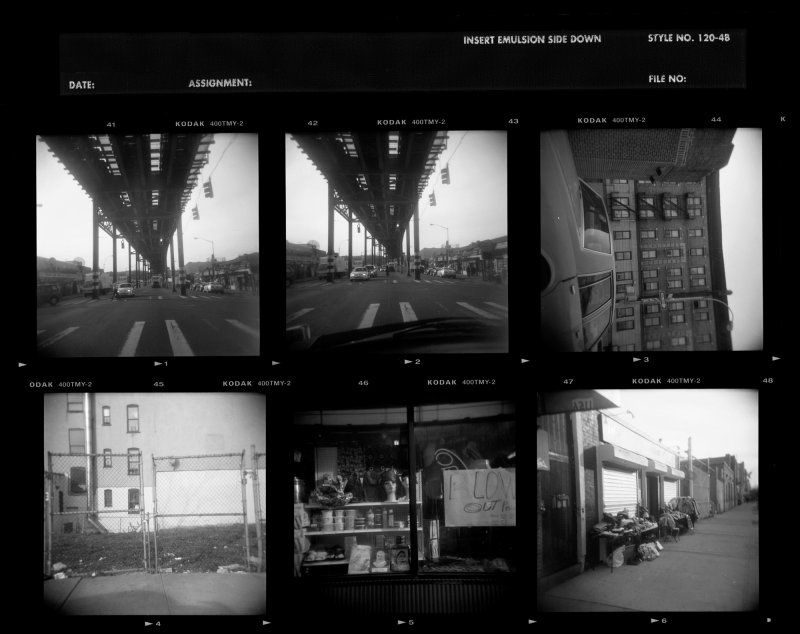
Elle Peréz, Bronx contact sheet, courtesy of the artist at 47 Canal
This August, 100 bus shelters across the city will feature a series of photographs, titled From Sun to Sun by Elle Peréz, to inaugurate Public Art Fund’s new partnership with street furniture company JCDecaux. This collaboration with the JCDecaux exhibition series further extends Public Art Fund’s history of transforming the city’s advertising spaces, with the intent to showcase photographers in the public realm. In June, in honor of the 50th anniversary of the Stonewall Uprising and WorldPride, Public Art Fund re-installed a piece it put up for the 20th anniversary of the uprising — Untitled, a black and white billboard created by Cuban-born artist Felix Gonzalez-Torres at Sheridan Square in Greenwich Village, above Village Cigars and across from the historic Stonewall Inn bar, where it first appeared in 1989.
The featured photographs in the bus shelter installation are a continuation of Peréz exploration of representation, identity and heritage of her Puerto Rican community in the Bronx. They often reveal intimate everyday moments highlighting the beauty of the individual in connection to their environment, and highlight the relationship between people and places. Public Art Fund Assistant Curator Katerina Stathopoulou explains that from sun to sun is a chance to exhibit Perez’s photography “within the diverse communities where the images were made, making this a deeply personal project,” and that Public Art Fund is thrilled for Peréz work “to inspire individuals to embrace points of similarity and humanity among the seemingly disparate people that comprise this city.”
Specific bus shelter locations will be announced shortly, and the works will be on view from August 13 to November 24, 2019.
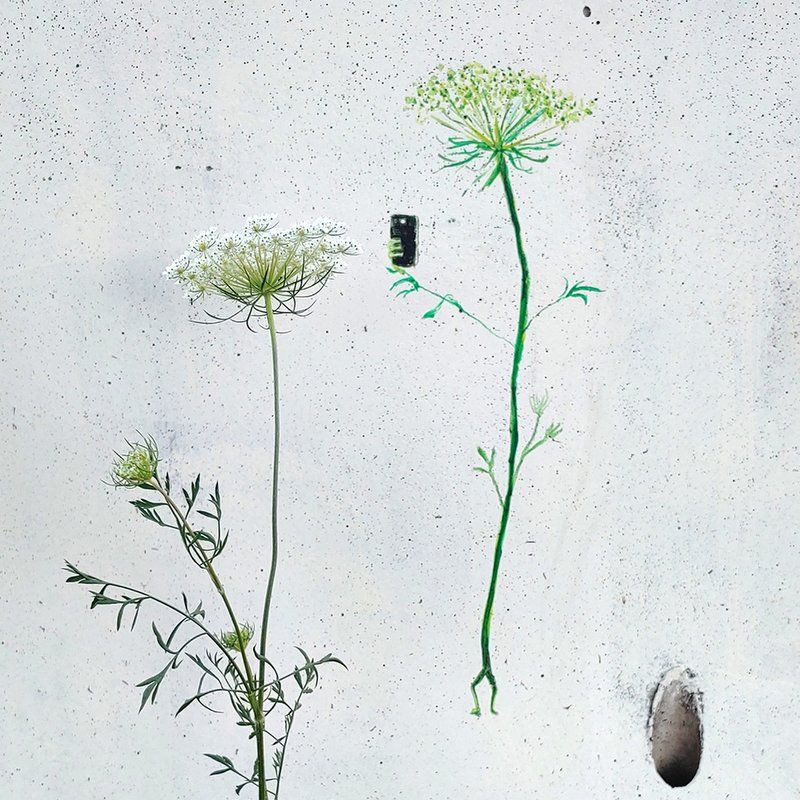
Photo courtesy Che-Min Hsiao
Artist Che-Min Hsiao and a group of other artists were selected to beautify the Elmhurst Sculpture Garden, as part of an ongoing effort by Queens Art Intervention (RPGA Studio) to use public sculpture art art to increase quality of life and health in the neighborhood. The organization was founded by artist Yvonne Short, who has many pieces out this month throughout New York City. Each artist was tasked with enriching the space with their own artistic voices (sculpture, sound art, performance, installation, painting).
In Day Parade of Plants by Che-Min Hsiao (above), look closely at the whimsical watercolor-like drawings and find anthropomorphized plants holding a cell phone, playing drums, and other activities. Yidan Zheng will install a collaborative sound art installation of wind chimes in the garden to “create an unconventional symphony among the traffic noise,” Margaret Roleke will create a sculpture of shotgun shells as “a thought provoking message on gun violence while acting as a shield for the garden,” and performance artists The Moving Company will create a site-specific performance piece.

While you may have seen one of Tom Fruin’s mosaic glass water towers from afar – from the Brooklyn-Queens Expressway or from the street in Williamsburg – it is a rare treat to see one up close. Now, one of his water tower works is on display inside The Shops at Hudson Yards. This work, and an accompanying glass house from Fruin’s Kolonihavehus series, are an initiative of AVANT Gallery, located inside 30 Hudson Yards. An escalator goes by the water tower so you can get peer inside on the ride up or from the second floor balcony. Smaller original and scale models, even an adorable night light version of Kolonihavehus (which are inspired by the shape of a garden house), are available for purchase in the gallery.
Fruin’s work involves not only offering a twist on iconic urban imagery, but also repurposing industrial materials. He sources discarded metal, offcuts and plexiglass pieces from sign shops in Chinatown. Kolonihavehus at Hudson Yards, much like a recent larger installation at Empire Stores, can be walked into and people are using it as an opportunity for Instagram photos.
Next, read on for the other public art installations in NYC that are still viewable this month!

Photo courtesy New York Botanical Garden
The New York Botanical Garden is celebrating the legacy of famous Brazilian artist Roberto Burle Marx with one of its most immersive experiences yet: a combination museum, landscape, and performance collection. For the duration of the 2019 summer season, visitors to the botanical garden can expect more than just beautiful foliage but also a breathtaking tribute to Brazil, which combines the art and landscape of Burle Marx with traditional song and dance.
Brazilian Modern: The Living Art of Roberto Burle Marx, is open through September 29, 2019
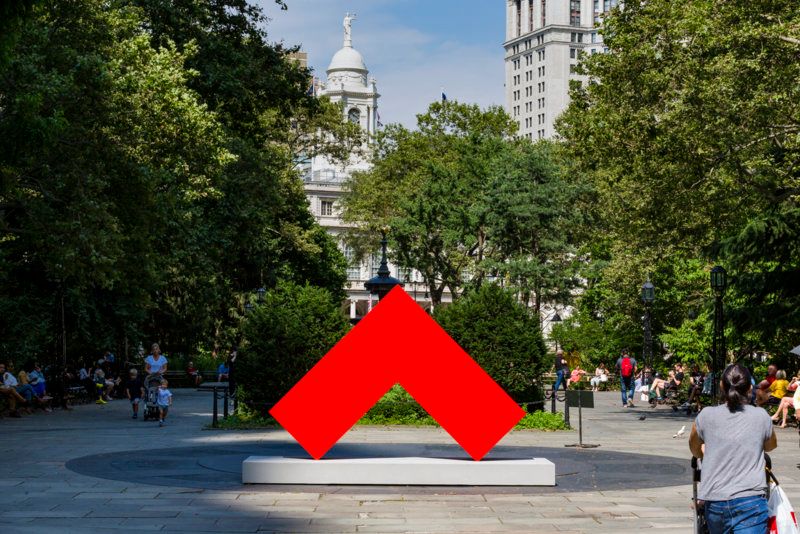 Photo: Nicholas Knight, Courtesy of Public Art Fund, NY
Photo: Nicholas Knight, Courtesy of Public Art Fund, NY
Estructuras Monumentales is a current exhibition in City Hall Park composed of five aluminum sculptures. It is designed by Cuban-born, New York based artist Carmen Herrera, and presented by Public Art Fund in celebration of her first major outdoor exhibition of sculptures. These works are to enliven City Hall Park in Lower Manhattan, where three new sculptures based on historic designs and two sculptures never before seen in the United States will be revealed.
Herrera’s Estructuras series was originally conceived in the 1960s, and featured bold monochromatic colors that are to complement the civic environment. According to Public Art Fund Associate Curator, Daniel S. Palmer, the series “will harmonize with the natural surroundings of this civic setting – City Hall Park serves as the ideal environment for this important exhibition in Herrera’s long career.”
Estructuras Monumentales will be on view from July 11 to November 8, 2019 in Lower Manhattan’s City Hall Park.
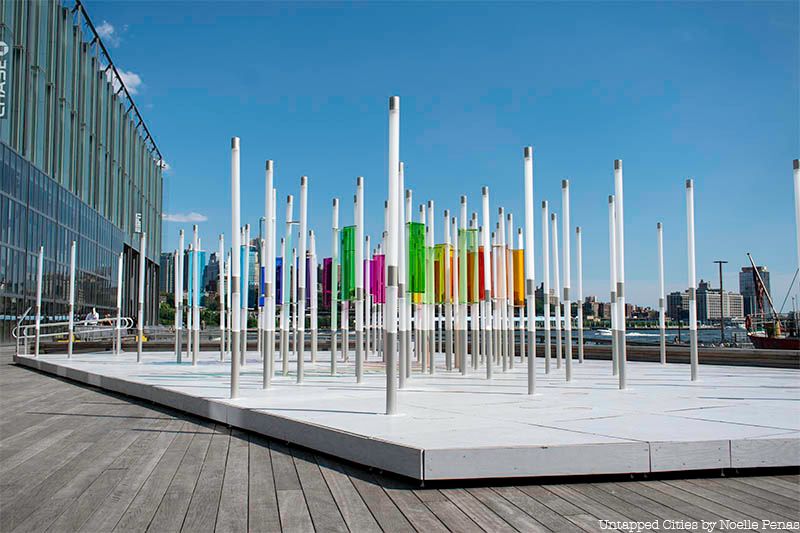
Located in the Seaport District of Lower Manhattan, this large-scale public art installation, a symmetric cluster of 95 interactive poles, comes alive under the direct touch of its viewers. It is a product of the collaboration between Lincoln and Atlantic Re:think, and is born from the mission of inviting passive viewers to engage with the art through sensory interaction and see it respond. The electrical field around the poles, like a touchscreen, can sense a hand’s touch and answer to it. Once activated, the poles light up and play a personalized melody.
Despite of–or perhaps because of being enabled by technology–this installation by the waterfront aspires to creating an experience that is inherently human. The Nautilus will be on view at Pier 17 in New York City’s Seaport District until September 10, 2019.
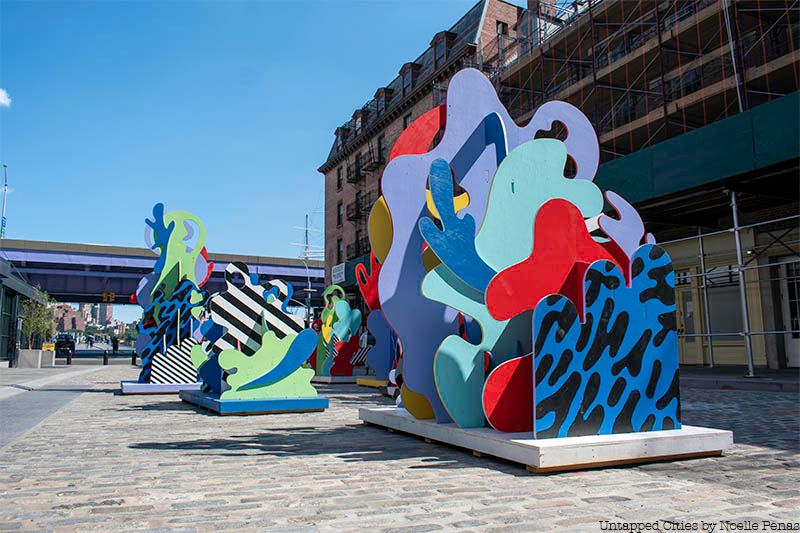
In South Street Seaport of Lower Manhattan, sculptures of kelp and coral formations created by Wade and Leta have been installed. Splashed with bright colors and replicating the inventive and organic forms of the ocean vegetation the title refers to, they make a vivid and playful addition to this summer’s assortment of public sculptures in the city.
Seascape Sculptures are located on the cobblestones at Fulton and Front streets, and are inspired by the historic ships docked nearby at Pier 16. The Seascape Sculptures will be on display until September 2019.

Photo by Max Touhey
For the fifth year in a row, Citi Habitats in partnership with K&Co and Pliskin Architecture have collaborated to resurrect the Pop-Up Pool Party at Roosevelt Island‘s Manhattan Park rental apartments. Each summer since 2015, a new artist has been commissioned to transform the pool deck into an alluring and mesmerizing work of art that lasts only for each pool season. Previous artists such as HOT TEA, Andrew Farris, Gregg Emery, and Technodrome1 have each incorporated unique elements to the project but maintained a bright summertime feel. The design of the installation spans across the entirety of the pool deck allowing spectators to not only admire but also feel immersed within the art as they walk on top of it.
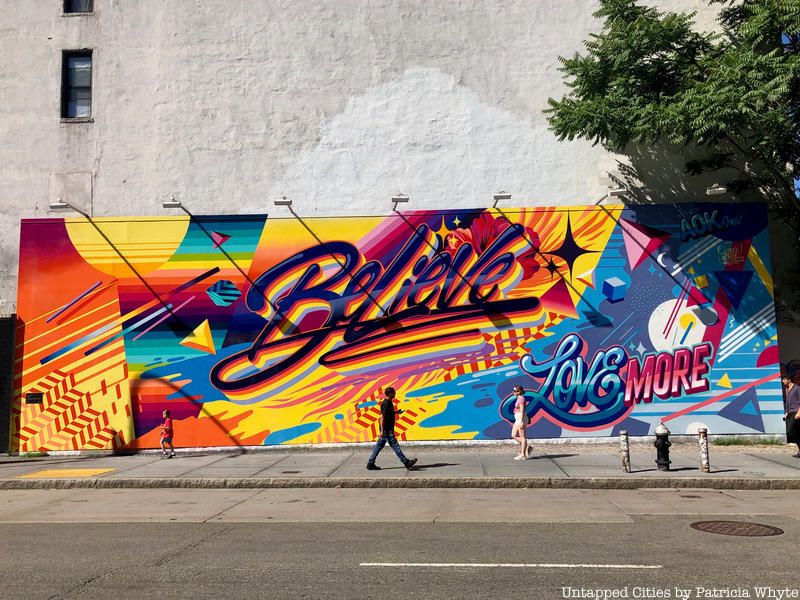
A changing of the guard has taken place in the Bowery. The Bowery Mural Wall, which was most recently covered in a colorful homage to the Lower East Sid by Bronx-based Tats Cru, will next be painted by Queen Andrea. Queen Andrea, or Andrea Von Bujduss, is an artist and professional graphic designer who started working on her Bowery mural in the end of May. She is known for using super bright colors and and fun bubbly text in her work.
The Houston Bowery Wall has been a canvas for great art since the 1970s when Keith Haring painted a mural there. In the ensuing decades a variety of artists have been commissioned to leave their creative mark on the wall. Previous works featured on the wall include an anti-gun piece by world-renowned artist JR and a protest piece by Banksy.
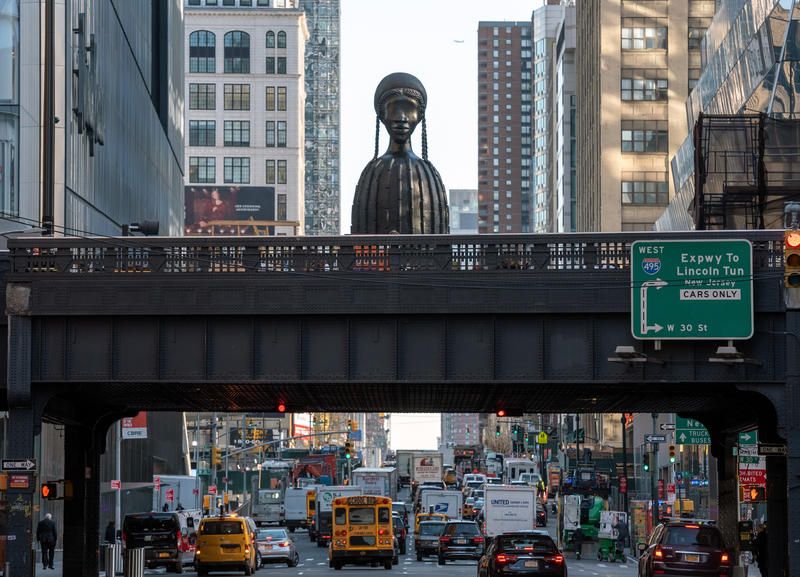
Simone Leigh, Brick House, 2019. A High Line Plinth commission. On view June 2019 – September 2020. Photo by Timothy Schenck. Courtesy the High Line
For about two months, Simone Leigh’s Brick House has been admired from afar as it loomed over 10th avenue. This month, visitors can get an up close look at the giant sculpture when the Spur, the newest section of the High Line opens on June 5th. It is the first sculpture to be displayed in the new space, which will host a series of rotating exhibits.
Brick House, a sixteen-foot-tall bronze bust of a black woman. Her head is adorned with an afro and cornrow braids along her hairline. The figure sits atop the Plinth, a new exhibition space at on the plaza of the Spur. Brick House is the first work in the series Anatomy of Architecture by Simone Leigh. The series of sculptures will intermingle architectural forms from West Africa to the American South with the human body.
Brick House will be up until September 2020.
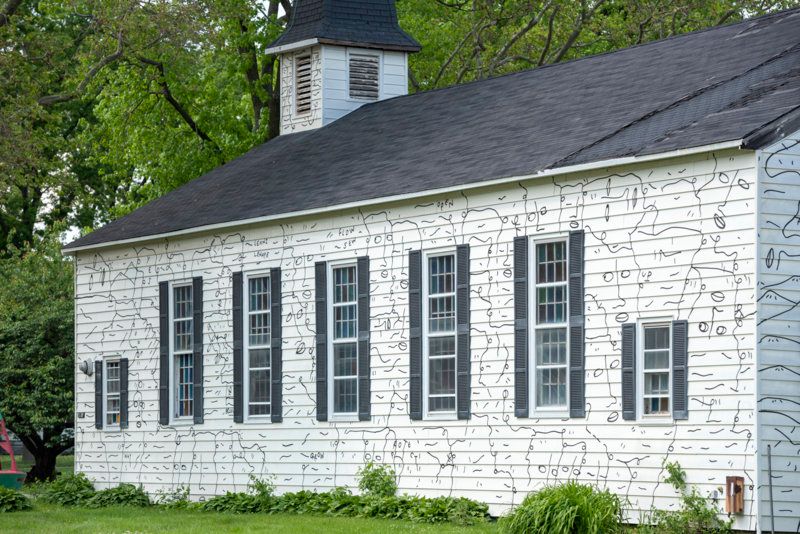
Photo by Timothy Schenk courtesy Trust for Governors Island
This June, the historic Our Lady Star of the Sea chapel will be transformed by the signature black and white drawings of artist Shantell Martin. Our Lady Star of the Sea chapel is a former military chapel that was built in 1942 as part of an expansion of the former U.S. Army base on Governors Island. Martin’s work will be the first installation to activate the space which is located in the Island’s Historic District. Her drawings will transform the exterior of the chapel, wrapping all the way around the entire structure and encouraging visitors to circumnavigate the it as they follow the narrative of her images.
The exhibition opens to the public beginning June 1st and will be on view daily through October 31. Throughout the fall there will be expanded, site-specific programming including poetry readings from the Poetry Society of America inspired by Martin’s work.
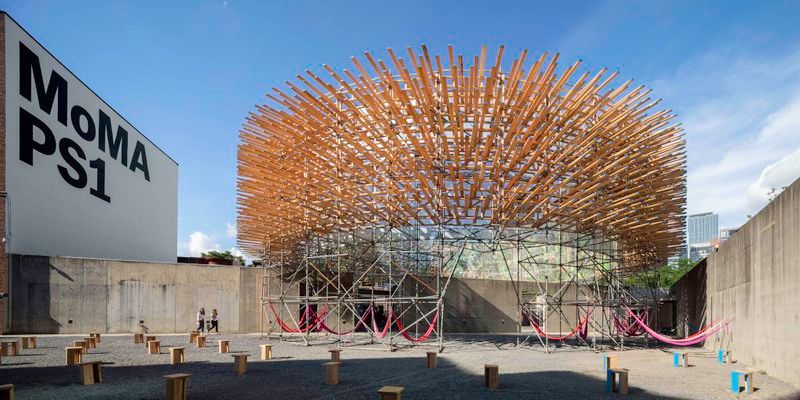 Photo: © Rafael Gamo, courtesy MoMA PS1
Photo: © Rafael Gamo, courtesy MoMA PS1
These days, the courtyard of MoMA PS1 resembles the rainforest more than New York City. The museum’s outdoor courtyard will be transformed this June by the winners of The Museum of Modern Art and MoMA PS1’s 20th annual Young Architects Program, Hórama Rama by Pedro & Juana (Ana Paula Ruiz Galindo & Mecky Reuss). Hórama Rama is an immersive junglescape set within a large-scale cyclorama that will hover over the museum’s exterior courtyard walls. The piece stands forty feet tall and ninety feet wide and feature a waterfall as well as hammocks crafted in Mexico. The installation, which is on view through September 2nd, serves as a temporary venue for MoMA PS1’s outdoor music series Warm Up.
Galindo and Reuss’s piece was selected from among five finalists who were part of the Young Architects Program. The program offers emerging architectural talent the opportunity to design and present innovative projects each year with challenge to come up with creative designs for a temporary and sustainable outdoor installations that provide shade, seating, and water. The architects must also work within environmentally sensitive guidelines.
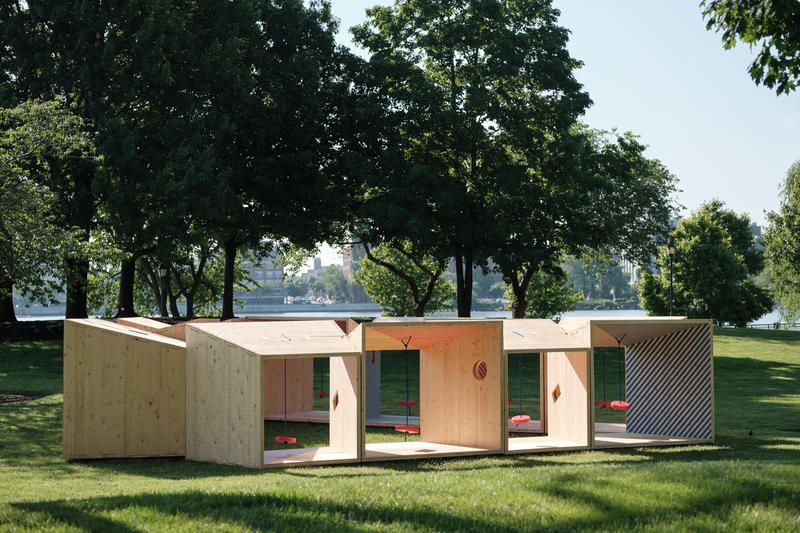 Photograph by James Lengs, Courtesy of FIGMENT NYC
Photograph by James Lengs, Courtesy of FIGMENT NYC
Another installation that will be unveiled at FigmentNYC is the Salvage Swing Pavilion created by Somewhere Studio. The Salvage Swing Pavilion was the winner of FIGMENT’s annual City of Dream Pavilion Competition, a contest challenges designers to consider the environmental impact of their designs and aims to promote sustainability-oriented thinking in the architecture and design communities. Unlike most of the FIGMENT installations which will only be up for the weekend, this pavilion will remain through August.
Salvage Swings is made up of scrap cross-laminated timber panels salvaged from an ongoing construction project at the University of Arkansas. There are twelve swing modules that frame the swinger and the swinger’s view. All of the modules are identical in size but vary with different painted patterns, hatches and windows. Not letting any material go to waste, the wood cut out for windows is used to make the swing seats. At Roosevelt Island, the modules are organized in a triangular form which enable community swinging, creates a covered seating area and a interrupted visual field (great for hide-and-seek games), and a large central space which can be used to host community events. The modular design allows for the swings to be easily separated following the summer installation so they may be relocated to parks and schools across New York City as individual swings.
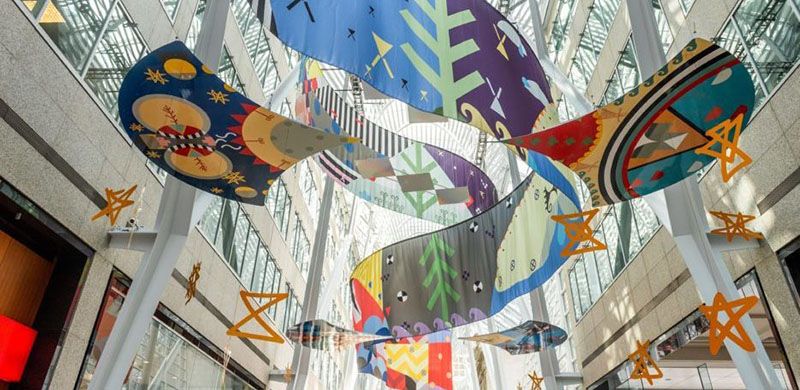
Photo courtesy of Arts Brookfield
Inspired by the themes of ancestral and contemporary traditions, the new installation at Brookfield Place by Canadian-born artist Jordan Bennett draws from his Native heritage. The installation takes its name by Mi’kmaq, the word for “night” in his native language, and the materials are a combination of of 3M Diamond Grade reflective on aluminum and printed polysilk fabric. Through this reflection on the changing social dynamics of Native American communities, Bennett has woven a site-specific installation that considers the idea of storytelling as well as connecting a diverse audience of visitors.
Tepkik will be on display from July 9th until September 6th at Brookfield Place.
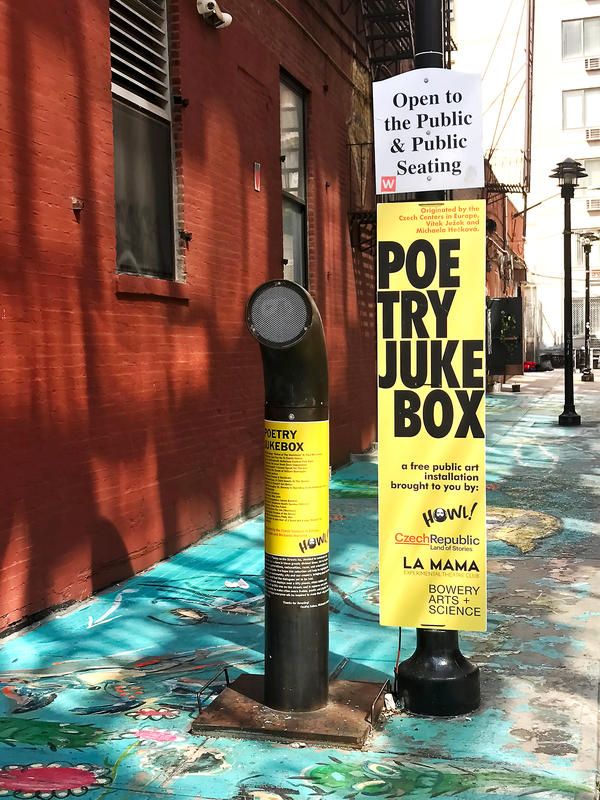 Photograph by Ted Riederer
Photograph by Ted Riederer
A new poetry jukebox has popped up outside Howl! Happening, a gallery, performance space and archive in the East Village, and Extra Place, where it was located in 2017. The poetry jukebox is loaded with poems by writers like Allen Ginsberg, James Baldwin, Hettie Jones, Margaret Randall and more.
The poetry jukebox first appeared at the Howl! Festival 2017 where coffeehouse owners from the Czech Republic introduced the funky speaker as part of an installation. The over two dozen poems were curated by Bob Holman and BC Edwards and represent a collective response to social justice.
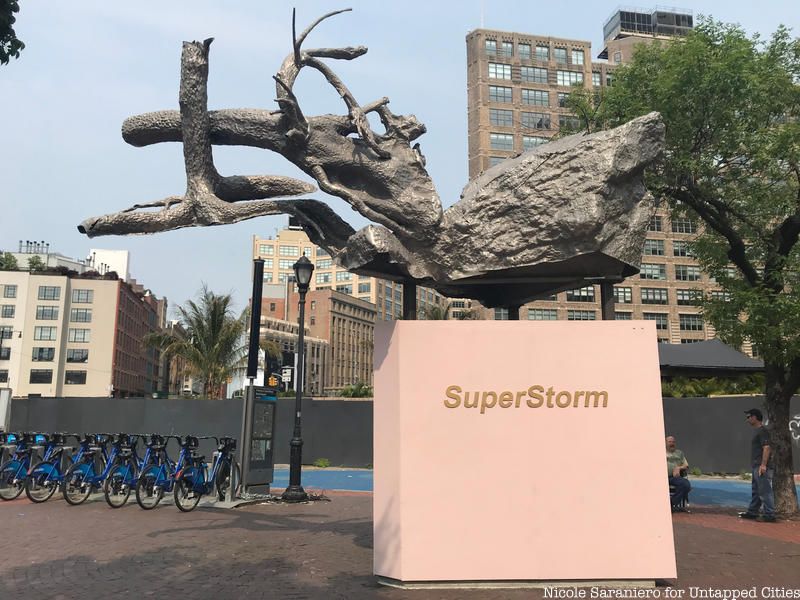
A new sculpture in Duarte Square Park commemorates one of the most intense natural disasters New York City has faced. Inspired by the destruction of Superstorm Sandy, Robert Lobe’s sculpture takes the shape of the storm’s wreckage. Superstorm is made up of hammered metal in the shape of a tree and boulder that were blown apart during the storm. The form was captured by actually taking a cast of the tree and boulder in the forest.
The tree once stood in the forest along the Appalachian Trail in Northwest New Jersey at Harmony Ridge Farm and Campground. During the storm, the tree was blown over and Lobe said “it had become a majestic horizontal sculpture with a flat circular root pattern spiraling vertically into the air, evidence of the shallow yin and yang sloping surface of its former boulder home.” The art piece shows “the unfriendly side of nature” and how superstorms are becoming a more intense and frequent problem as our climate changes. Superstorm can be found at the intersection of Avenue of the Americas and Canal Street until June, 2020.
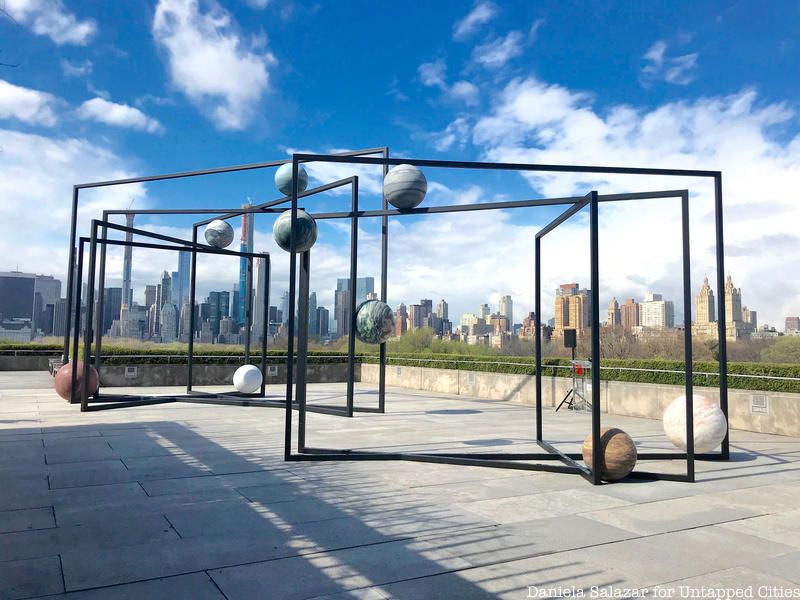
The Metropolitan Museum of Art Roof Garden Commission has a new work for the season. Parapivot, by Alicja Kwade is a duo of works made out of steel and stone to capture a miniature solar system. Kwade is a Berlin-based artist who seeks to “heighten both the mystery and absurdity of the human condition in order to enhance our powers of self-reflection.”
This piece will be on display on the Iris and B. Gerald Cantor Roof Garden until October 27, 2019. Parapivot is Kwade’s first solo exhibition at a museum in the United States.
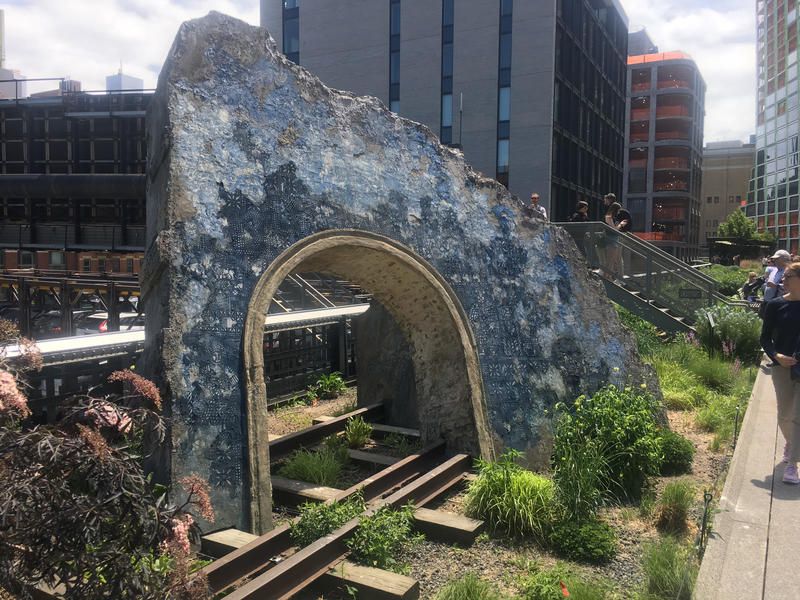
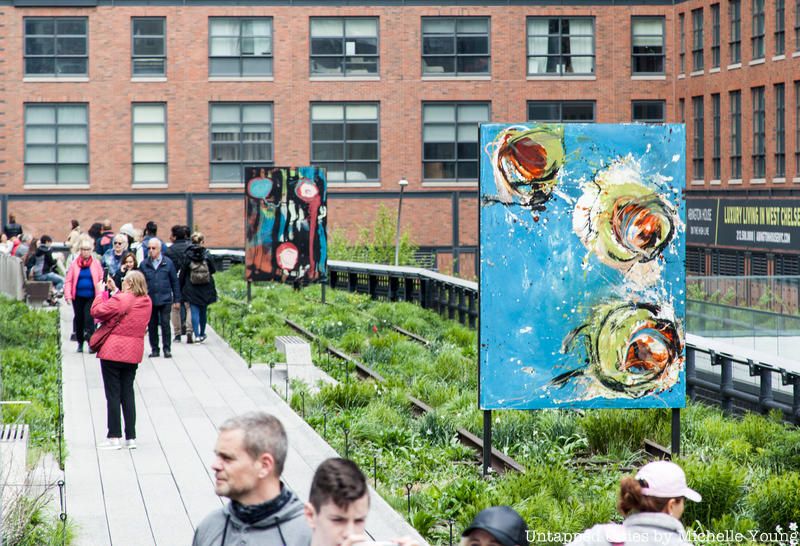
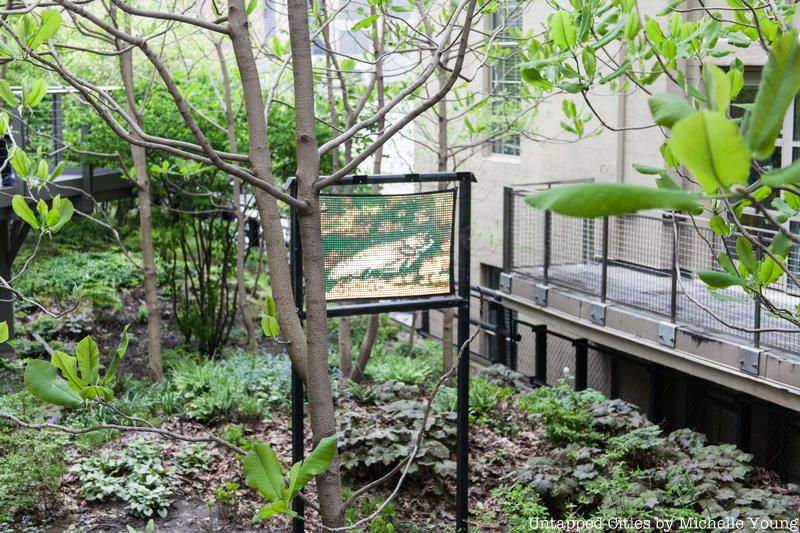
“En plein air” refers to the 19th century practice of painting outdoors, something inspired by, and a reaction to, the extreme changes happening in urban areas during the Industrial Revolution. The High Line, being a remnant of New York City’s industrial era, is the perfect place to reexamine and re-explore the tradition of outdoor painting, and with the involvement of several international artists, En Plein Air is an annual installation that challenges conventional sculptures and murals with freestanding, outdoor paintings that explore and restructure the relationship between art, nature and the modern urban city.
The first work above at 20th Street is by Firelei Báez, she depicts a Haitian Sans-Souci Palace ruin that looks like it is collapsing into the High Line. As High Line Arts describes, “In this ongoing body of work, Báez examines incarnations of Sanssouci: the 18th century Rococo palace built by Frederick the Great, the palace of Haitian Revolution leader and proclaimed first King of Haiti Henri Christophe, and Haitian revolution leader Jean-Baptiste Sans Souci, who was assassinated by Henri Christophe.” The second work, a series of four resign paintings, above is by Ryan Sullivan, embedded into the rail lines and plantings at 29th Street.
At 26th Street. Japanese artist Ei Arakawa has created two LED light paintings of fish, an interpretation of French painter Gustave Courbet’s 1872 and 1873 paintings, both titled La truite (The Trout). Other works include hundreds of striped flags at the Western Rail Yards by French artist Daniel Buren (known for his columns at the Palais Royal in Paris), ceramic archways by American artist Sam Falls embedded with fossilized plants from the High Line, life-size portraits on reclaimed doors from Georgian townhouses by Tanzanian artist Lubaina Himid, a large-scale sculpture at The Spur by Lara Schnitger, and a series of unstretched canvases inspired by an artist Vivian Suter Argentian home greet visitors at the southern edge of the park.
En Plein Air will be on display at several locations on the High Line from April 19, 2019 to March 30, 2020.
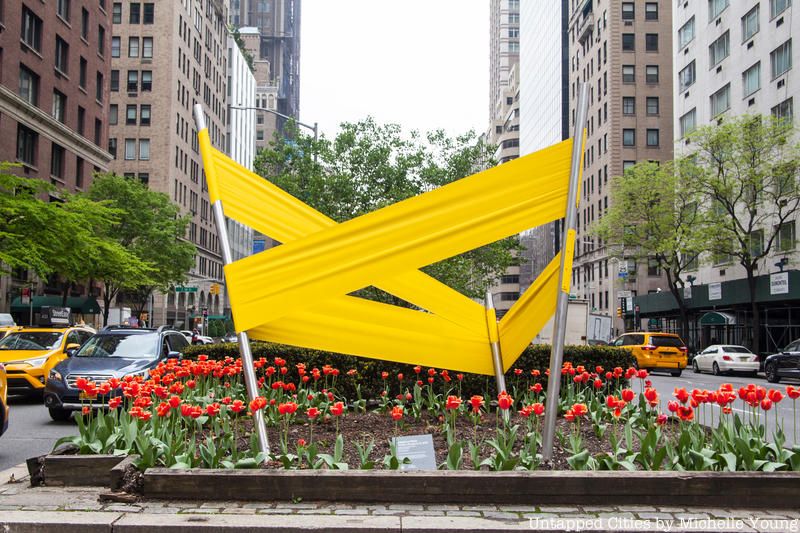
The Park Avenue Malls have been a place for artists to show off their works for years, and now Joseph La Piana’s Tension Sculptures are on display, taking on the form of five different structures exploring questions of “passive materiality.” Each sculpture takes on a different shape and dimension, and all are comprised of yellow, rubber sheets stretched almost unbelievably tight around thick, steel beams. The tension visualized in these “living sculptures,” as La Piana describes them, is supposed to parallel the current political and social climate while also portraying hope, as these are materials that, though pushed to their limits, will not collapse.
Tension Sculptures will be on display on Park Avenue at 53rd, 57th, 60th, 67th and 70th Streets until August 11th, 2019.

In partnership with New York City Audubon, Broadway Mall Association, New York City Parks Department, and Gitler & Gallery, artist Nicolas Holiber presents, “Nicolas Holiber: Birds on Broadway, Audubon Sculpture Project”. The National Audubon Society posted its Birds & Climate Change Report in September 2014, which cautioned that half of all North American bird species will be endangered over the coming decades as a result of global warming.
Artist Nicolas Holiber chose 12 out of the 145 species of birds that reside in New York City to include in the Audubon Sculpture Project. The twelve sculptures will be made out of reclaimed wood sourced from the city itself and located between 64th and 157th Streets. The project seeks to bring “attention to the plight of birds threatened by climate change while simultaneously bringing beauty to the urban landscape.” This installation will on display until January 2020.
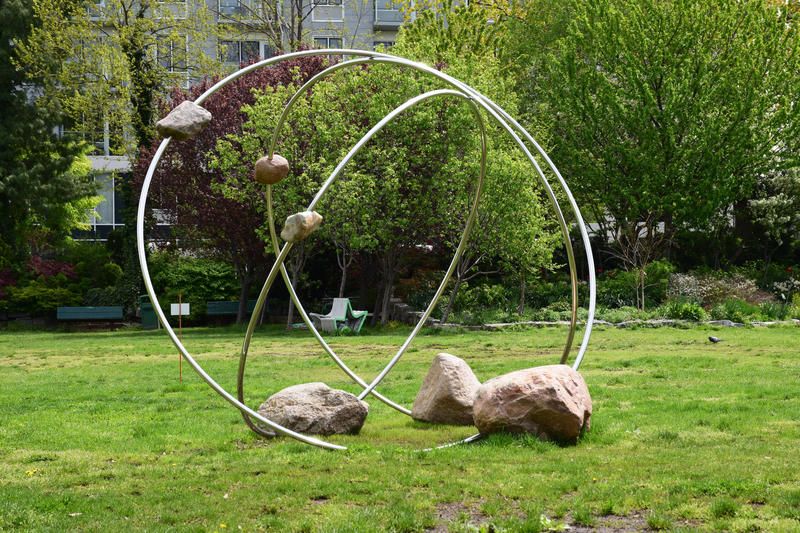
Photograph courtesy of Sara Morgan
Opened on May 5, 2019, Chronos Cosmos: Deep Time, Open Space is a multi-collaborative exhibition in Socrates Sculpture Park that will highlight and put into question our preconceived notions of time, space, matter and our relationship to them and each other. Eight different artist will create art installations for the Long Island City waterfront park, taking advantage of the open-air environment, and present their personal interpretation of time, history and space, taking inspiration from an array of sources including astrophysics and non-western modes of thought. The goal is to upset and reorient the viewers’ perspectives on time and space, revealing alternative ways of interacting with the world and the people in it.
The artists participating in the exhibition are Radcliffe Bailey, Beatriz Cortez, Alicja Kwade (whose work is also on the Met Museum rooftop) Eduardo Navarro, Heidi Neilson, Miya Ando, William Lamson, and Maria Rapicavoli, and the exhibition will be on display until September 2, 2019.
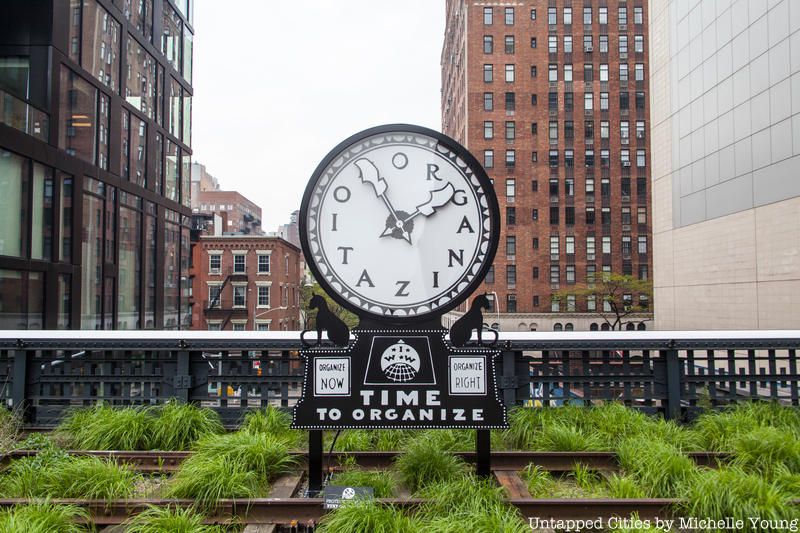
Ruth Ewan’s large-scale, double-sided clock, visible from the street, is based on the Industrial Workers of the World (IWW) labor union’s illustrations; the clock was once one of the many images used on “stickerettes,” otherwise known as “silent gators,” and distributed by union members as they travelled from job to job. The clock was an homage to the round-the-clock work of the union, as well as a callout to factory owners and how they divided public and private time. Ruth Ewan’s work now serves as a call to action for today’s labor struggles and the fight for diminishing labor rights, including the five-day work week and eight-hour work day.
Ruth Ewan’s Silent Agitator is the artist’s first public installation in the United States and will be on display on the High Line Park at 24th Street from April 3, 2019 to March 31, 2020.
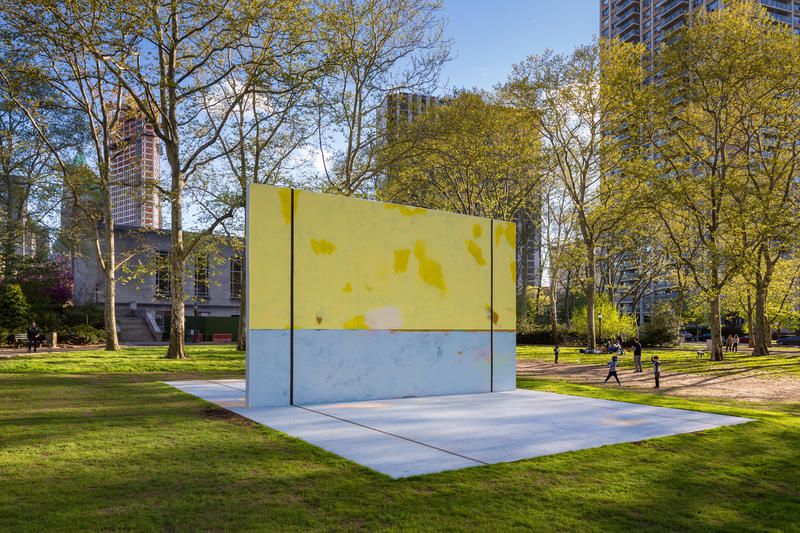
Harold Ancart, Subliminal Standard at Cadman Plaza Park presented by Public Art Fund, 2019. Photo: Nicholas Knight, Courtesy of Public Art Fund, NY
In May The Public Art Fund unveiled Subliminal Standard, an interactive commission by Belgian artist Harold Ancart. Set up in the northern end of the Cadman Plaza Park in Brooklyn, Subliminal Standard is a large painted concrete sculpture inspired by the handball courts made popular in the 1900s by U.S. immigrants. The installation will be a place of play and interaction, inviting the viewers to immerse themselves in the piece and consider the relationship between handball courts, playgrounds and abstraction.
Subliminal Standard is Ancart’s first public art commission in the United States, and will be on display until March 1, 2020.
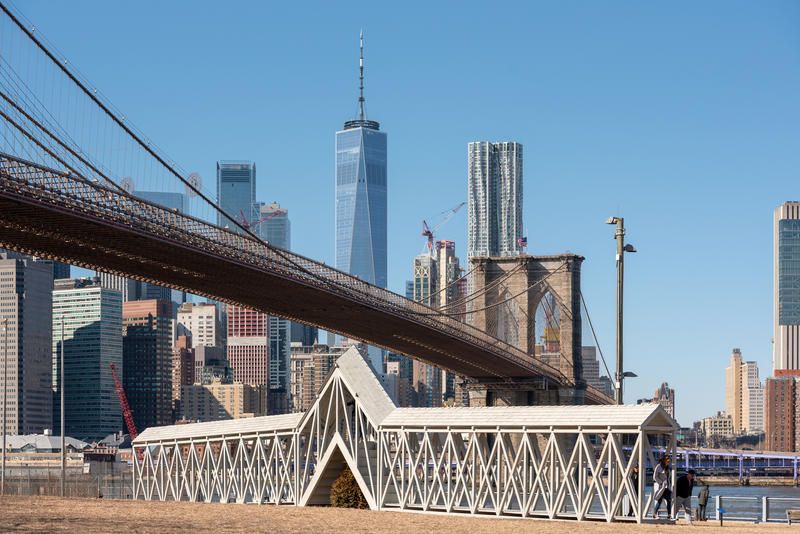
Siah Armajani, Bridge Over Tree, 2019, photograph by Timothy Schenck, courtesy Public Art Fund, NY
Siah Armajani’s public art installation Bridge Over Tree debuted at Walker Art Center in Minneapolis in 1970. Nearly fifty years later, the piece will be on display again in a re-staging at Brooklyn Bridge Park starting February 20th. The piece blurs the line between art and architecture, as does most of Armajani’s work which consist largely of outdoor structures. Bridge Over Tree is a 91-foot-long walkway with a shingled roof and stairs at the middle that arch over a small tree. The piece, presented by the Public Art Fund, will be installed between the Manhattan and Brooklyn Bridges on the Empire Fulton Ferry lawn. Bridge Over Tree is the only outdoor piece associated with Siah Armajani: Follow This Line, a new retrospective exhibit of Armajani’s career at the Met Breuer.
The installation will be up until September 29, 2019.
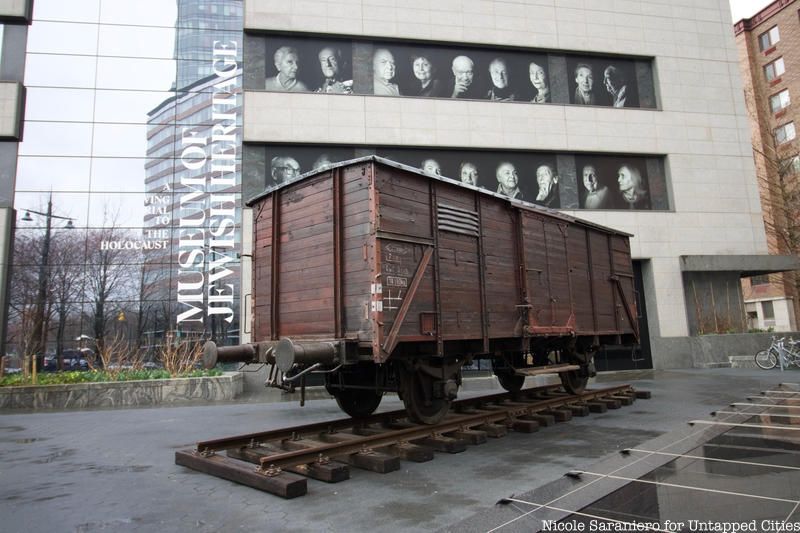
In Battery City Park at the Museum of Jewish Heritage, an actual artifact from the early twentieth century is now on display. This freight car is not a replica and was actually used by the German National Railway during World War II to transport soldiers, prisoners of war, and then Jews to killing centers.
The freight car is an element of the upcoming exhibition Auschwitz. Not long ago. Not far away. will be on view until January 3, 2020 and include over 700 artifacts from World War II never before seen in the United States.
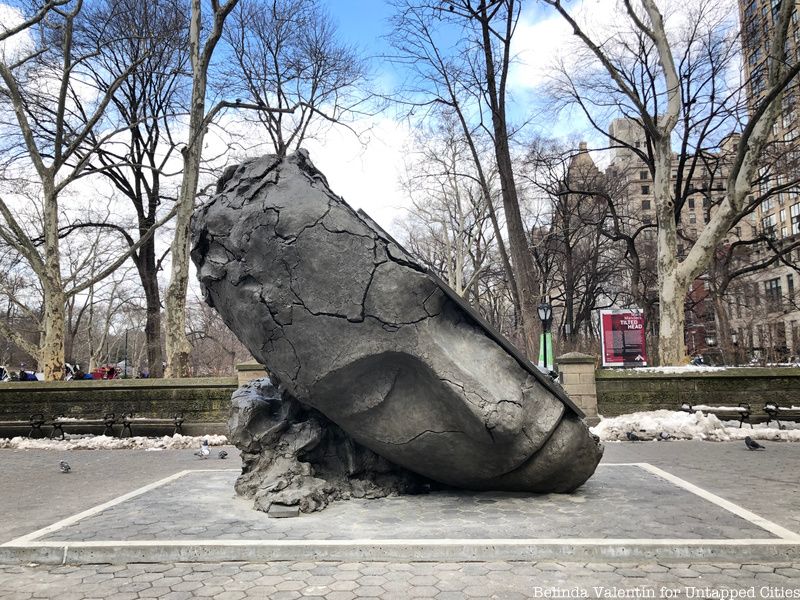
On March 6, Dutch artist Mark Manders’ largest single cast bronze sculpture opened at the Central Park entrance at 60th Street and 5th Avenue. Titled Tilted Head and debuted by the Public Art Fund, the 13-foot-tall human head is made of clay-looking bronze and was commissioned for Doris C. Freedman Plaza. Tilted Head is Mark Manders’ “largest single cast bronze sculpture to date” and this is the first time it’s been in New York City. The mysteriously unfinished sculpture’s cracks juxtapose the tranquil expression on the head’s face.
The installation will be on display until September 1, 2019.
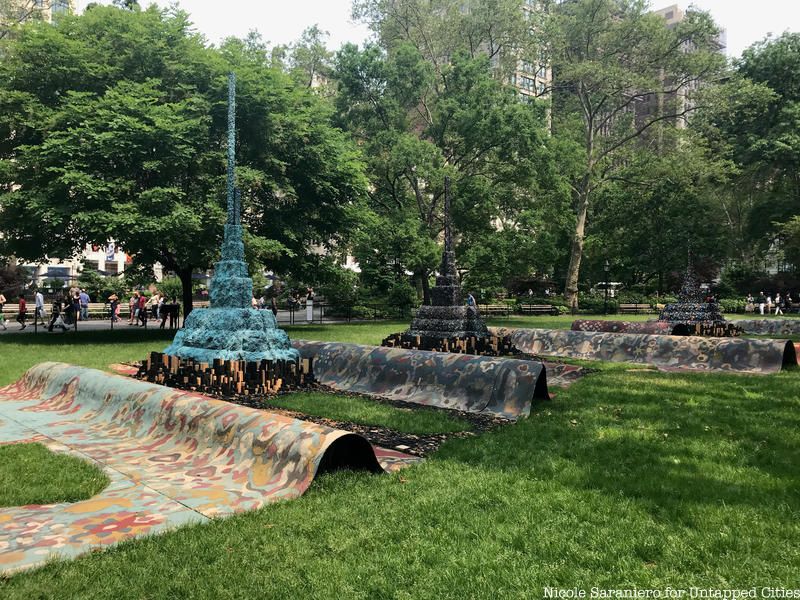
To mark the 38th commission of the Madison Square Park Conservancy, New York-based artist Leonardo Drew was chosen to create a monumental installation on the park’s Oval Lawn. Drew’s City in the Grass will present a topographical view of an abstract cityscape atop a multi-patterned, undulating and layered panorama. The installation stretches 100 feet long.
City in the Grass is made of varied materials that spread across the lawn and, at various points, ascend into tall rising towers. The sculptures are set in a patterned surface that mimics Persian carpet designs and reflects the artist’s interest in East Asian decorative traditions and global design. The sculpture mixes domestic and urban motifs, spurring viewers to contemplate our relationship to the city we will in. City in the Grass will be on view from June 3, 2019, through December 15, 2019.
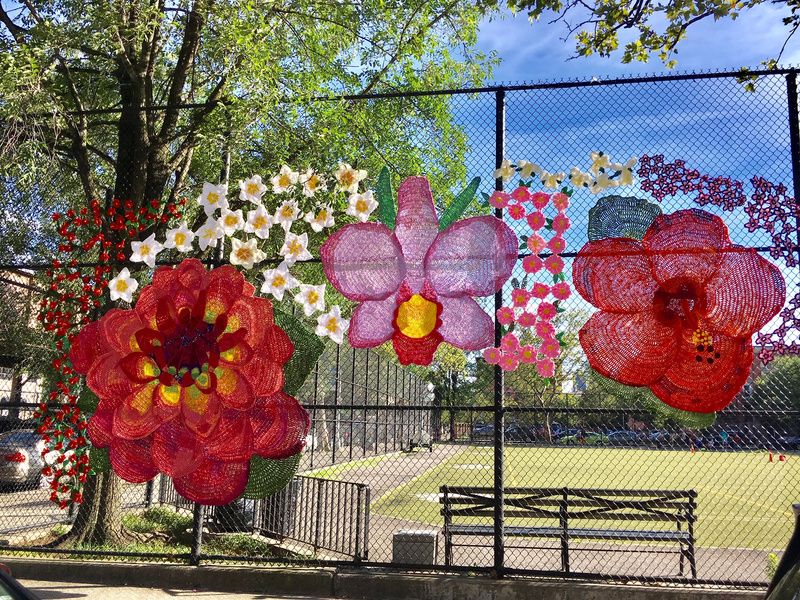 Photograph Courtesy of NYC Parks
Photograph Courtesy of NYC Parks
Two new installations are coming to the fence at Euguene McCabe Field in Harlem. One of those new installations if La Flor De Mi Madre created by artist Naomi Lawrence. This site-specific piece, which stretches 12-feet by 24-feet, is made up of a variety of vibrantly colored crocheted flowers that represent the different cultures that make up the surround community. There are Frangipani that represent the Ivory Coast, a Christmas Orchid for Columbia, Bayahibes for the Dominican Republic a giant Dalia for Mexico a Hibiscus for Ghana and more. The installation is being sewn together with help from community members. The flowers will adorn the fence from July 1, 2019 to July 1, 2020, at Eugene McCabe Field, 1718 Park Avenue at 121st Street in East Harlem.
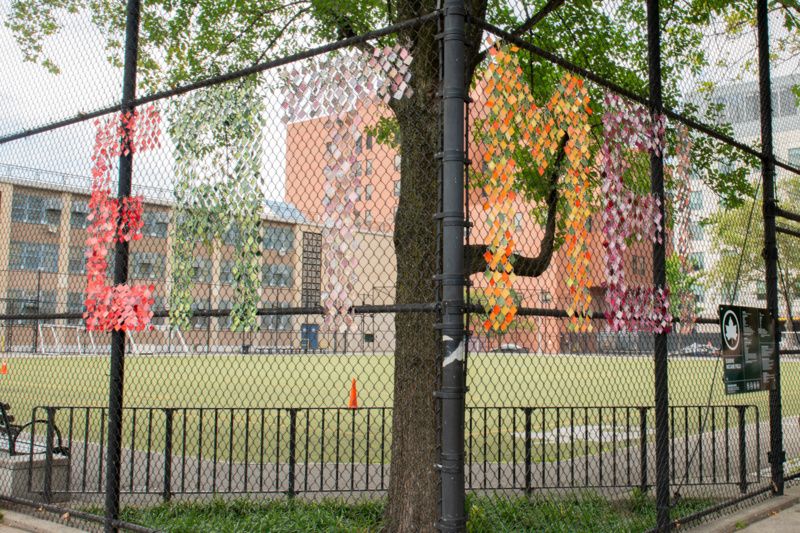 Photograph Courtesy of Capucine Bourcart
Photograph Courtesy of Capucine Bourcart
The second installation going up on the fence is EAT ME! by Capucine Bourcart. Each letter of the mosaic piece is made up of close-up images of different types of food, from beans and strawberries to meat and fish. EAT ME!
will be on view along Park Avenue between 120th/121st Street. Both Lawrence’s and Bourcart’s installations will be welcomed with an opening reception on Tuesday, July 9th at 6:00pm on Park Avenue between 120th/121st Street in Harlem.
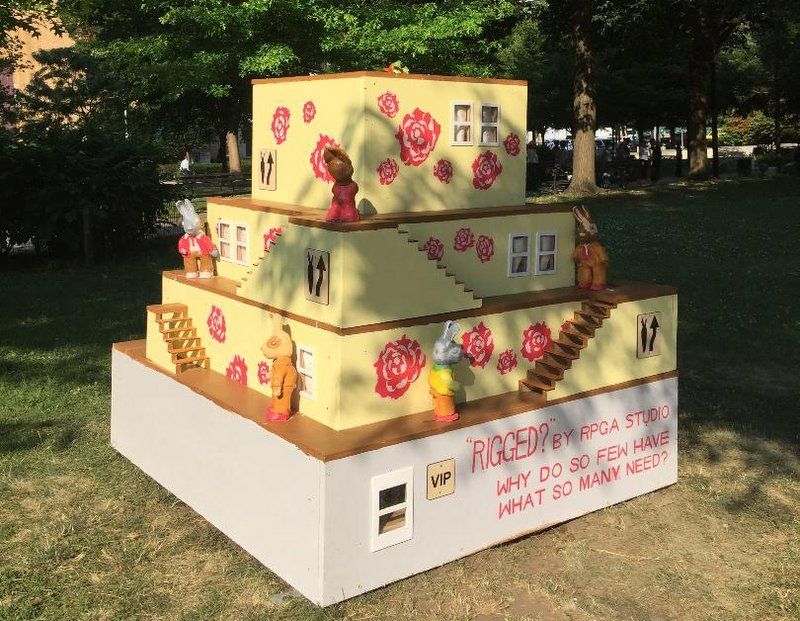 Photo courtesy of Yvonne Shortt
Photo courtesy of Yvonne Shortt
Rabbits are invading MacDonald Park in Forest Hills, Queens. Forest Hills resident and artist Artist Yvonne Shortt worked with her studio team and students from York College, Queens College, International High School of Health Sciences, and Academy of American Studies to cast and paint clay sculpted bunnies for her new installation Rigged?. The installation is a maze with stairs and windows that the bunnies are trying to navigate to get to the bunch of carrots on the top level.
A sign on each level leads to the next staircase, until the level just before the top. It is impossible to complete the maze. In a secret entrance at the bottom of the piece, one rabbit hoards a stash of carrots. The rabbit maze is a commentary on the social, economic, and political system. It will be on display from July 10th, 2019 through July, 2020.
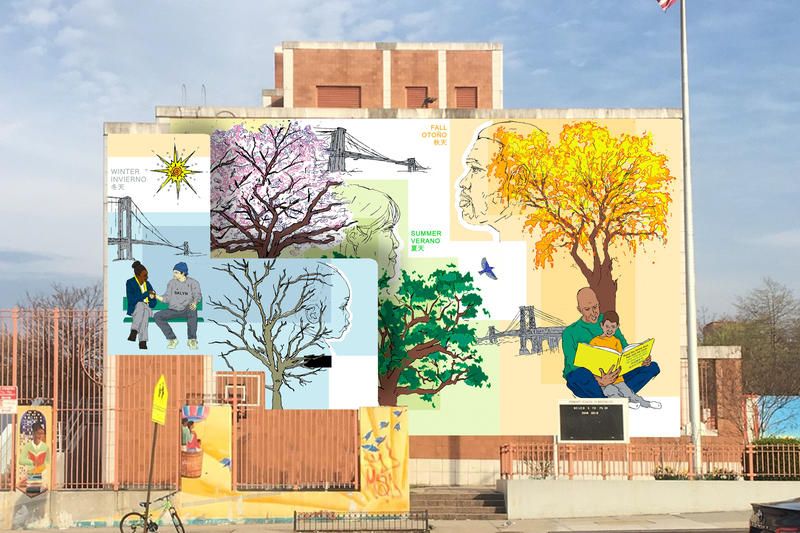
Feeling All Four Seasons, Bridging All Four Seasons” by artist Julia Cocuzza and members of Baltic Street, AEH, Inc., will be installed on PS 24K at 427 38th St. in Sunset Park, Brooklyn.
The NYC Mural Arts Project aims to erase the stigma of mental illness while enhancing the physical environment of New York City’s communities through beautiful, collaborative, murals. Two new murals will be unveiled this month in Sunset Park, Brooklyn and Graniteville, Staten Island. The designs were developed by local artists in collaboration with neighborhood residents, people with mental health conditions, and peer specialists through a series of public events and weekly workshops in the community. The murals were even partially painted by community members at two community paint-fests.
The first mural, Feeling All Four Seasons, Bridging All Four Seasons is by artist Julia Cocuzza and members of Baltic Street, AEH, Inc. It will be installed on PS 24K at 427 38th St. in Sunset Park, Brooklyn. The second mural, We are a Connected Community is by artist Alice Mizrachi and members of Venture House, and will be installed on PS 22 1860 Forest Avenue in Graniteville, Staten Island.
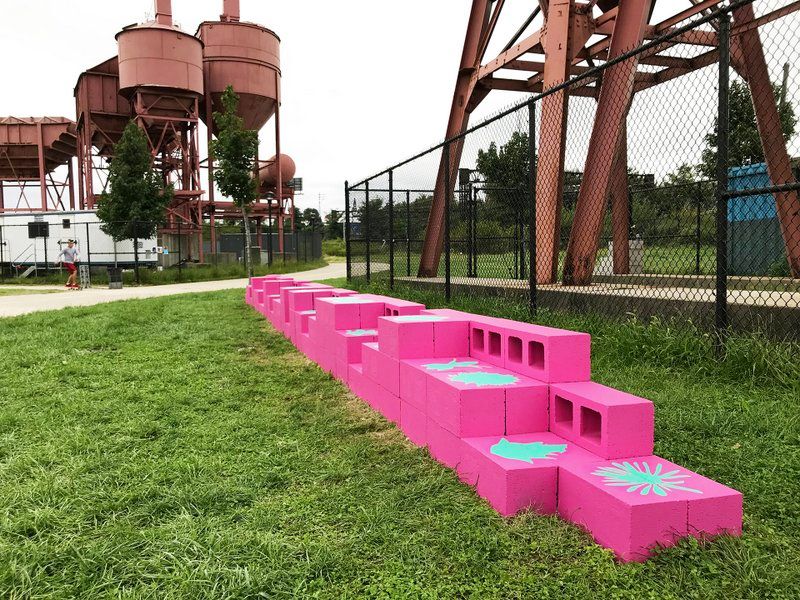
Photo courtesy Sohhee Oh, via NYC Parks
A relatively new NYC Parks Art in the Parks installation is up in Concrete Plant Park in the Bronx. Artists Sohhee Oh, Lovie Pignata, and Moses Ros have created a three connected works: a long bench of painted concrete blocks that reference native plants from the Bronx River Foodway, geometric concrete pavers that are inspired by Bronx’ original native dwellers, the Mohegans, along with its current diverse population and colorful flags at the entrances of the a park that were designed in conjunction with the local community.
Concrete Plant Park was previously a location for Swale, the foragable floating food forest. The installation will be up until September 27, 2019.
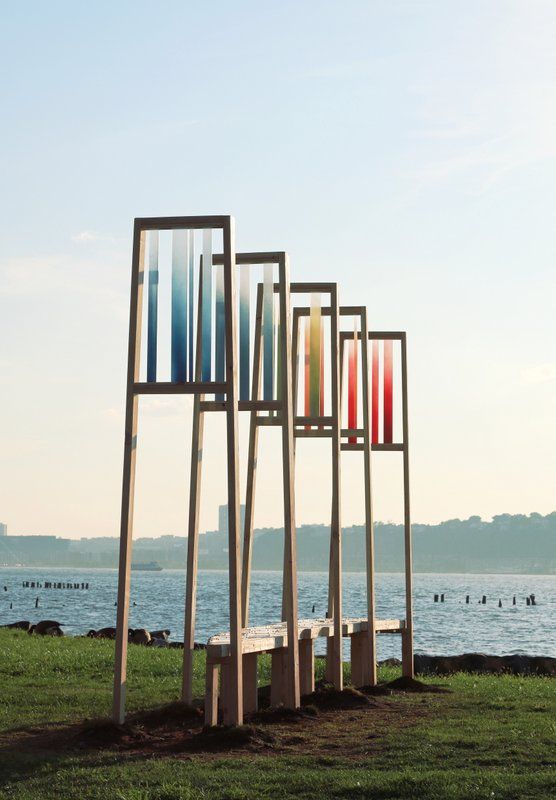
Photo courtesy Sarah E. Brook
Viewfinding, a large-scale public art installation in Riverside Park by Gowanus-based artist Sarah E. Brook, features a series of reclaimed lumber and cast-acrylic panels, with engraved text written by 26 queer-identified poets. The acrylic material is selected for its translucency and will shift in color depending on the sunlight and time of day. The poets selected include not only established ones, but also not yet published ones as well.
Viewfinding is located along the Hudson River in Riverside Park at 67th Street and will be up until August 22nd, 2019.
Next, check out our upcoming tours to explore more of New York City!
Subscribe to our newsletter